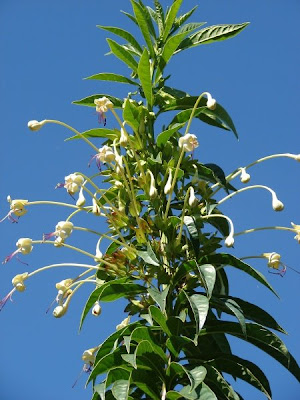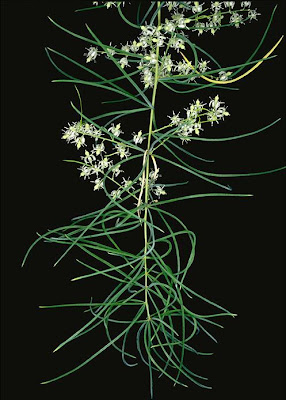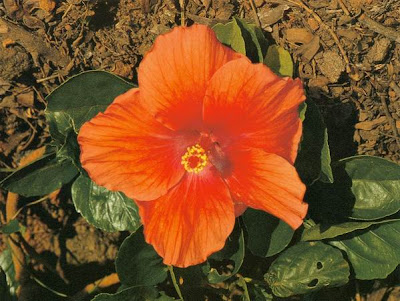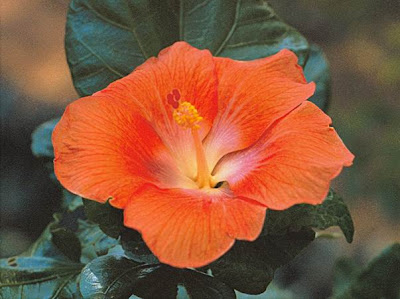Flowers are the moment’s representations of things that are in themselves eternal. -Sri Aurobindo
A B C D E F G H I J K L
M N O P Q R S T U V W Y

There is one divine Force which acts in the universe and in the individual and is also beyond the individual and the universe. The Mother stands for all these, but she is working here in the body to bring down something not yet expressed in this material world so as to transform life here -- it is so that you should regard her as the Divine Shakti working here for that purpose. She is that in the body, but in her
whole consciousness she is also identified with all the other aspects of the Divine.
from Volume 25, "The Mother", p. 49-50, 1920
SRI AUROBINDO
The Mother's presence is always there; but if you decide to act on your own idea, your own notion of things, your own will and demand upon things, then it is quite likely that her presence will get veiled; it is not she who withdraws from you, but you who draw back from her.
from Volume 25, "The Mother", p. 117, 1920
SRI AUROBINDO
The Mother's consciousness is the divine Consciousness and the Light that comes from it is the light of the divine Truth, the Force that she brings down is the force of the divine Truth. One who receives and accepts and lives in the Mother's light, will begin to see the truth on all the planes, the mental, the vital, the physical. He will reject all that is undivine, -- the undivine is the falsehood, the ignorance, the error of the dark forces; the undivine is all that is obscure and unwilling to accept the divine Truth and its light and force. The undivine, therefore, is all that is unwilling to accept the light and force of the Mother. That is why I am always telling you to keep yourself in contact with the Mother and with her light and Force, because it is only so that you can come out of
this confusion and obscurity and receive the Truth that comes from above.
When we speak of the Mother's Light or my Light in a special sense, we are speaking of a special occult action -- we are speaking of certain lights that come from the Supermind. In this action the Mother's is the White Light that purifies, illumines, brings down the whole essence and power of the Truth and makes the transformation possible. But in fact all light that comes from above, from the highest divine Truth is the Mother's.There is no difference between the Mother's path and mine; we have and have always had the same path, the path that leads to the supramental change and the divine realisation; not only at the end, but from the beginning they have been the same.
The attempt to set up a division and opposition, putting the Mother on one side and myself on another and opposite or quite different side, has always been a trick of the forces of the Falsehood when they want to prevent a Sadhak from reaching the Truth. Dismiss all such falsehoods from your mind.Know that the Mother's light and force are the light and force of the Truth; remain always in contact with the Mother's light and force, then only can you grow into the divine Truth.
from Volume 26, "On Himself", p.455, 10 September 1931SRI AUROBINDO

What Sri Aurobindo represents in the world's history is not a teaching, not even a revelation; it is a decisive action direct from the Supreme.
from Volume 13, "Words of the Mother", pp.1-35, 14 February 1961
THE MOTHER
Sri Aurobindo came upon earth to teach this truth to men. He told them that man is only a transitional being living in a mental consciousness, but with the possibility of acquiring a new consciousness, the Truth-consciousness, and capable of living a life perfectly harmonious, good and beautiful, happy and fully conscious. During the whole of his life upon earth, Sri Aurobindo gave all his time to establish in himself
this consciousness he called supramental, and to help those gathered around him to realise it.
from Volume 12, "On Education", p.116, 24 July 1951
THE MOTHER
When in your heart and thought you make no difference between Sri Aurobindo and me, when to think of Sri Aurobindo will be to think of me and to think of me will mean to think of Sri Aurobindo inevitably, when to see one will mean inevitably to see the other, like one and the same Person, then you will know that you begin to be open to the supramental force and consciousness.
from Volume 13, "Words of the Mother", pp.1-35, 4 March 1958
THE MOTHER
 n, an a day, she sent me in a letter petals of the pomegranate flower, "Divine's Love". At that time I had not given the meaning to the flower. She sent me petals of pomegranate flowers telling me that these petals were bringing me her protection and force.
n, an a day, she sent me in a letter petals of the pomegranate flower, "Divine's Love". At that time I had not given the meaning to the flower. She sent me petals of pomegranate flowers telling me that these petals were bringing me her protection and force.
“When I had written it all was effaced; but now the blood of the cherry tree flows in my veins and with it flows and incomparable peace and force, what difference is there between the human body and the body of a tree? In truth, there is none; the consciousness which animates them is identically the same.
Then the cherry tree whispered in my ear:
“It is in cherry-blossom that lies the remedy for the disorders of spring.”
*
There are certain illnesses that people get particularly in Spring- boils, impurities of the blood, etc.- which the Japanese cure with teas made from cherry-blossoms. I did not know this when I had experience.


 No, the compassion does not wither with its symbol - flowers are moment's representation of things that are in themselves eternal.
No, the compassion does not wither with its symbol - flowers are moment's representation of things that are in themselves eternal.When the consciousness is narrow and personal or shut in the body, it is difficult to receive from the Divine - the wider it expands, the more it can receive. A time comes when it feels as wide as the world and able to receive all the Divine into itself.
SRI AUROBINDO
 Photo Courtesy: Cbcastro
Photo Courtesy: Cbcastro
 Photo Courtesy: Essjay
Photo Courtesy: Essjay
 Photo Courtesy: Cbcastro
Photo Courtesy: Cbcastro
 Photo Courtesy: Eric in SF
Photo Courtesy: Eric in SF
 Photo Courtesy: Earth
Photo Courtesy: Earth Photo Courtesy: Koizumi
Photo Courtesy: Koizumi Photo Courtesy: Forest & Kim Starr
Photo Courtesy: Forest & Kim Starr Photo Courtesy: Electriclibrarian
Photo Courtesy: Electriclibrarian Photo Courtesy: Cliff1066
Photo Courtesy: Cliff1066 Photo Courtesy: Dinesh Valke
Photo Courtesy: Dinesh Valke

 Picture Courtesy: Variationen
Picture Courtesy: Variationen Picture Courtesy: KENPEI
Picture Courtesy: KENPEI
 Photo Courtesy: Sriaurobindoashram.com
Photo Courtesy: Sriaurobindoashram.comBlessings[My blessings are] for the Will of the Lord to be done, with full force and power. So it is not necessary that there should always be a success. There might be a failure also, if such is the Will of the Lord. And the Will is for the progress, I mean the inner progress. So whatever will happen will be for the best.
THE MOTHER

 Photo Courtesy: Ellievanhoutte
Photo Courtesy: EllievanhoutteThe New BirthWhen I speak of "New Birth" I am always speaking of the birth of a new consciousness.
THE MOTHER
What is called "new birth" is the birth into the spiritual life, the spiritual consciousness; it is to carry in oneself something of the spirit which individually, through the soul, can begin to rule the life and be the master of existence.
THE MOTHER
You become a new person, and whatever your path or its difficulties later on, that feeling never leaves you. It is not even something, like many other experiences, which recedes, passes into the background, leaving you externally with a kind of vague memory that is difficult to hold, a memory that grows faint and blurred — it is not that. You are a new person and you are definitively that, whatever happens. And even all the incapacities of the mind, all the difficulties of the vital, all the inertia of the physical are unable to change this new state - a new state that makes a decisive break in the life of the consciousness. The being one was before and the being one is after, are no longer the same. The position one has in the universe and in relation to it, in life and in relation to it, in understanding and in relation to it, is no longer the same: it is a true reversal which can never be undone again.
THE MOTHER

 Photo Courtesy: Forest & Kim Starr
Photo Courtesy: Forest & Kim Starr Photo Courtesy: Van swearingen
Photo Courtesy: Van swearingenBird of ParadiseThe soul of man soars as the Bird, the Hansa, past the shining firmaments of physical and mental consciousness, climbs as the traveller and fighter beyond earth of body and heaven of mind by the ascending path of the Truth to find this Godhead waiting for us, leaning down to us from the secrecy of the highest supreme. . ..
SRI AUROBINDO
 Photo Courtesy: Forest & Kim Starr
Photo Courtesy: Forest & Kim Starr Photo Courtesy: Sriaurobindoashram
Photo Courtesy: Sriaurobindoashram Photo Courtesy: Forest & Kim Starr
Photo Courtesy: Forest & Kim StarrBroadening of the BeingThere is no happiness in smallness of the being, says the Scripture, it is with the large being that happiness comes. The ego is by its nature a smallness of being; it brings contraction of the consciousness and with the contraction limitation of knowledge, disabling ignorance. ... To recover what is lost we must break out of the worlds of ego.
SRI AUROBINDO
 Photo Courtesy: Cbcastro
Photo Courtesy: Cbcastro
 Photo Courtesy: TT
Photo Courtesy: TT Photo Courtesy: Tony from Sydney
Photo Courtesy: Tony from Sydney Picture Courtesy: Dinesh Valke
Picture Courtesy: Dinesh Valke Photo Courtesy: Nipplerings72
Photo Courtesy: Nipplerings72Realisation is ... when something for which you are aspiring becomes real to you; e.g. you have the idea of the Divine in all, but it is only an idea, a belief; when you feel or see the Divine in all, it becomes a realisation.
SRI AUROBINDO
In a more deep and spiritual sense a concrete realisation is that which makes the thing realised more real, dynamic, intimately present to the consciousness than any physical thing can be.
SRI AUROBINDO
 Photo Courtesy: Forest & Kim Starr
Photo Courtesy: Forest & Kim Starr Photo Courtesy: Tauʻolunga
Photo Courtesy: Tauʻolunga Photo Courtesy: Tony
Photo Courtesy: TonyLet Beauty be your constant ideal:
beauty of soul
beauty of sentiment
beauty of thought
beauty of action
beauty in work
so that nothing comes out of your hands which is not an expression of pure and harmonious beauty. And the Divine help will always be with you.THE MOTHER
In the world of forms a violation of Beauty is as great a fault as a violation of Truth in the world of ideas. For Beauty is the worship that Nature offers to the supreme Master of the universe; Beauty is the divine language in form. And a consciousness of the Divine that is not translated outwardly by an understanding and expression of Beauty would be an incomplete consciousness.THE MOTHER
Beauty is his footprint showing us where he has passed, Love is his heart-beats' rhythm in mortal breasts, Happiness the smile on his adorable face.
SRI AUROBINDO
Beauty is Ananda taking form - but the form need not be a physical shape. One speaks of a beautiful thought, a beautiful act, a beautiful soul. What we speak of as beauty is Ananda in manifestation. ...SRI AUROBINDO
 Photographer: Fagg, M
Photographer: Fagg, M Photo Courtesy: Fui
Photo Courtesy: Fui
 Photo Courtesy: Ram-Man
Photo Courtesy: Ram-Man
 Photo Courtesy: AdSR
Photo Courtesy: AdSR Photo Courtesy: Jeremy Raff-Reynolds
Photo Courtesy: Jeremy Raff-Reynolds
 Photo Courtesy: John
Photo Courtesy: John
 Photo Courtesy: Naturenick
Photo Courtesy: Naturenick

 Photo Courtesy: Hyougushi / Hideyuki KAMON
Photo Courtesy: Hyougushi / Hideyuki KAMON
 Photo Courtesy: Kropsoq
Photo Courtesy: Kropsoq
 Photo Courtesy: Toptropicals
Photo Courtesy: Toptropicals

 Photo Courtesy: Daryl Mitchell
Photo Courtesy: Daryl Mitchell
 Photo Courtesy: Heartlover1717
Photo Courtesy: Heartlover1717

 Photo Courtesy: it1315922
Photo Courtesy: it1315922
 Photo Courtesy: Dinesh Valke
Photo Courtesy: Dinesh Valke
 Photo Courtesy: Nemo's great uncle
Photo Courtesy: Nemo's great uncle
 Photo Courtesy: Kimberlyfaye
Photo Courtesy: Kimberlyfaye





 Photo Courtesy: Chrissy Olson
Photo Courtesy: Chrissy Olson Photo Courtesy:Forest & Kim Starr
Photo Courtesy:Forest & Kim Starr
 Photo Courtesy:BY-YOUR-⌘
Photo Courtesy:BY-YOUR-⌘

 Photo Courtesy: Inklaar
Photo Courtesy: Inklaar